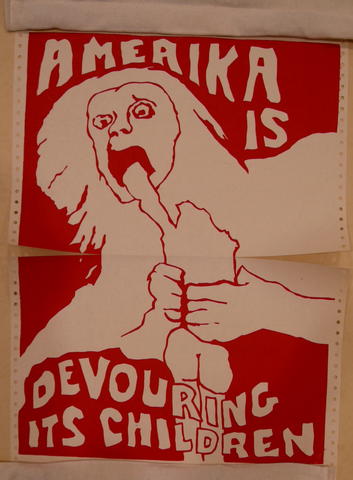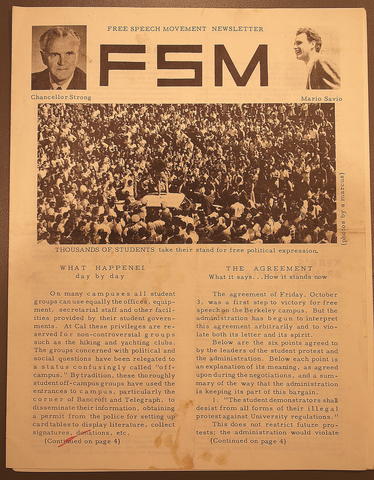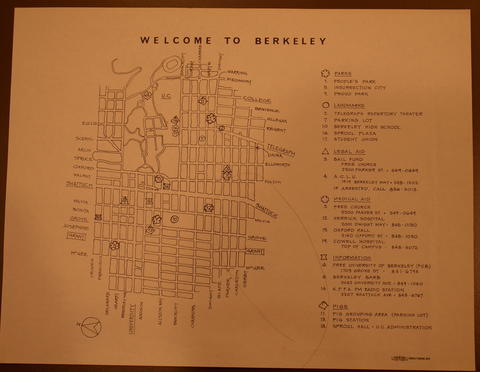Berkeley Barbs: 1968 on the West Coast
This session covered materials related to the Free Speech Movement and other protests at the University of California, Berkeley, as well as posters and ephemera from the Bay Area activities of the Black Panther Party.
The Berkeley Free Speech Movement was sparked in the fall of 1964, when Dean of Students Katherine Towle banned student groups from setting up tables on a 26-foot long strip of sidewalk, known as the Bancroft strip. In her letter, Towle elaborated that tables obstructed pedestrian traffic, adding, “University facilities may not, of course, be used to support or advocate off-campus political or social action.” For the next two weeks, student groups and Towle attempted to negotiate, but after student members of CORE and SNCC were suspended for tabling on September 30th, organizers changed tactics. 500 students occupied Sproul Hall for several hours that evening, before voting to leave and rally the following day at noon. At 10am on October 1st, two tables were set up on the Bancroft strip. In the late morning, CORE member Jack Weinberg was arrested. Hundreds of students surrounded the cop car, trapping it with Weinberg in it for 36 hours. Mario Savio famously spoke from on top of the car, and in the next several days, students organized to create the Free Speech Movement (FSM).
For the next several months, FSM actions rallied a broad coalition of student groups and faculty members. While Mario Savio is often recognized as the leader of the FSM, participants emphasize the non-hierarchical nature of the movement. The support of faculty members was integral to the FSM’s success, and may have been partially enabled by the memory of the loyalty oath controversy in 1949-1951. On December 8, 1964, the Academic Senate voted that the University could only regulate the time, place, and manner of political activity on campus, with no restrictions on the content of speech.
An extensive timeline of FSM activities is available online at the Bancroft Library.
The Black Panther Party (BPP) materials covered in this session focused on BPP activities in the Bay Area, from the Party’s founding in 1966 through Huey P. Newton’s release from prison in 1970. Founded as the Black Panther Party for Self-Defense by Bobby Seale and Huey P. Newton, the BPP’s initial activities centered around armed citizens’ patrols which monitored police brutality in Oakland, CA. In 1967, the Party published their ten-point platform of demands, including freedom, full employment, housing, and an end to police brutality. That summer, California outlawed open carry, forcing a halt to BPP patrols. In the fall, Huey P. Newton was arrested in the death of a police officer, and many Panther visual materials from 1967-1968 focus on the campaign to “Free Huey.” 5,000 demonstrators and 450 BPP members showed up to protest Newton’s trial in July 1968. While increased visibility rallied support, it also likely led to increased FBI surveillance and harassment of Panthers under COINTELPRO. Later that year, the Party founded its Survival Programs, including Breakfast for Children, which became a key part of BPP strategies. In July 1970, Newton was freed. In the early 1970s, many BPP chapters began to shut down, with others pivoting to focus on gaining election to political offices.
This greeting card bears the signature of Emory Douglas, the Black Panther Party’s Minister of Culture. The image of a revolutionary mother holding her child is an iconic trope among BPP visual materials, implying the importance of the desired revolution for the future of the depicted child. It also suggests the importance of women to the BPP cause.
This poster by the Political Poster Workshop at Berkeley, launched in May 1970, is printed on recycled computer paper. The Workshop was led by Malaquias Montoya, and its designs responded to recent political events, including the bombing of Cambodia and the Kent State shootings.
This poster was designed by Emory Douglas, Minister of Culture for the Black Panther Party. The bottom right corner bears the address for the Party’s Ministry of Information, demonstrating the importance of the organized dissemination of educational and visual materials in advancing the BPP’s aims. The poster also demonstrates the iconic and unified aesthetic of Douglas-designed material. The BPP slogans “All Power to the People” and “Free All Political Prisoners” appear on buttons worn by the two figures, while text appears above the image: “The heirs of Malcolm have picked up the gun and now stand millions strong facing the racist pig oppressor.”
This first issue of the Free Speech Movement Newsletter includes a photograph of Mario Savio speaking from the top of a police car in Sproul Plaza on October 1, 1964, the day of Jack Weinberg’s arrest. The image reveals the importance of physical protest to the FSM’s success, with the movement using sit-ins and mass rallies to disrupt University activities and gain leverage for the cause. Printed flyers, newsletters, and counterculture newspapers were also essential to building momentum, serving to inform students and faculty members about “What happened day by day,” as the lead article of this newsletter shows. Print media also offered a forum for movement leaders, participants, and even those who opposed the FSM to develop and present their political positions.
This map of Berkeley produced by Berkeley Graphic Arts shows the area surrounding and including the University of California, Berkeley campus, with icons indicating the location of parks, landmarks, legal aid, medical aid, information, and “pigs.” The contentious Bancroft strip which sparked the Free Speech Movement’s activities is located at the intersection of Bancroft Way and Telegraph Ave., near Sproul Hall (#18) the Student Union (#17). The map demonstrates the centrality of spatial politics to the FSM debates, which hinged in many ways on the division between campus and town. The ban on tables in the Bancroft strip indicated the administration’s position that political speech should only happen off-campus.
Designed by Emory Douglas, Minister of Culture for the Black Panther Party, the poster shows the identifiable graphic style. It depicts a African people, who are holding a pen-like weapon under the sunlight pattern. The bottom right corner mark the address for the Party’s Ministry of Information, presenting the strong organization of Black Panther Party. The text ”Afro-American solidarity with the oppressed people of the world” shows that Douglas and Black Panther Party shared the struggles in other third world countries, presenting their ideology of solidarity.





